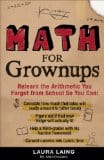Book Review: Math For Grownups
This blog is reader-supported. When you purchase something through an affiliate link on this site, I may earn some coffee money. Thanks! Learn more.
Read our review guidelines.

But many of us find math tricky. Laura Laing, in her book Math for Grownups, tries to put that right.
“Remember, it’s only a tool…It’s a language that describes how our world fits together,” she writes. “Math enables us to make predictions and quick decisions. Math helps us feel powerful and confident.”
Trying to remember how to calculate ratios can be hard when school was the last time you got out your scientific calculator. Laing writes:
“It’s completely understandable if you struggle with some basic math facts…When you understand why arithmetic works, you can make up for most any math fact that you’ve forgotten.”
Her book aims to explain why math works, to give you both the skills and the confidence you need to tackle everyday math problems. And if you can’t work it out yourself after reading this book, she recommends heading to the internet to find the formula that you need. This is not a book about making things harder than they need to be just to prove you can do long division in your head; there is no shame in using a calculator.
Math for Grownups is a book about changing your attitude to math. It covers skills like estimating and fractions, and explains them in the context of real world examples like using discount coupons in the supermarket. That doesn’t make it a basic text. Before you are 50 pages in to the book Laing is explaining negative exponents. The book has a useful appendix listing formulae and a glossary of math and financial terms.
Math for Grownups is also about reclaiming numbers for yourself. Math is not there to constrain you. The underlying message throughout the book is that math is your friend. Should you buy that snazzy new ice cream maker? Math will help you work out if you can afford it but even if you can’t, the choice is still yours. “Just remember that you-not the numbers on the page-make the final decisions,” writes Laing.
Throughout the book Laing presents simple tricks to make equations and calculations easier. Key to this is her philosophy about estimating. She introduces tips like dropping the fractions off numbers, doing the math with whole numbers and then adding the parts back on again. Doing math that gets you a good enough answer is all that is required.
“All through your math education, you were taught precise ways to solve problems. And you may have come away from that experience thinking that math depends on that degree of precision.
Sure, math is an exact science, but you get to decide when you need a precise answer and when an estimate will do. The key is thoughtful estimation. Make sure that you’re not cutting so many corners…that you end up with an estimate that is either too small or too large.
And when you get your solution, ask yourself this question: Is it reasonable?”
There are a lot of real-world examples from buying a car to scaling recipes to deal with a glut of tomatoes from the garden. There is nothing specific about work-related math like project budgets although Chapter 8 deals with household budgets. That section also looks at salary negotiations and now to calculate how much that raise is really worth if it pushes you into a higher tax bracket.
Laing gives readers the tools they need to get more confident with managing numbers. One way to do this is to practise in situations where the future of your project is not at stake, like calculating grams of fat on food labels, or working out how much each family owes when renting a holiday villa with friends.
Laing encourages us to have a relationship with numbers that puts us back in control.
If you feel like you struggle with calculating ratios and fractions or percent (for example when working out contingency budgets) then this is a confidence-boosting book.
This book review first appeared on Gantthead.com in July 2011.
